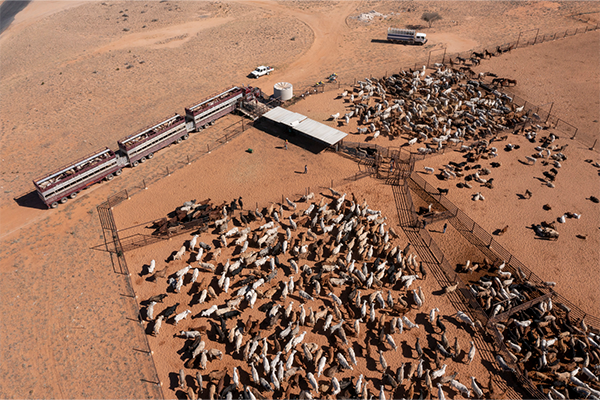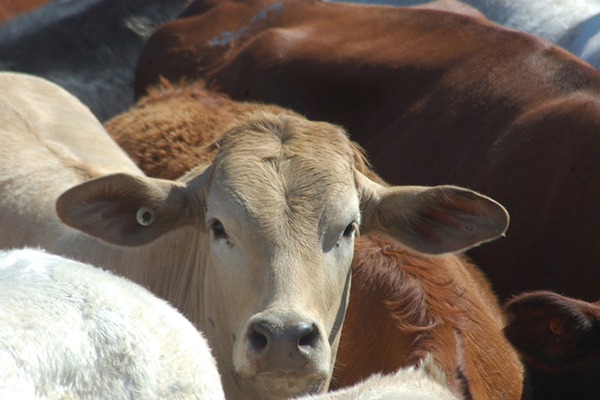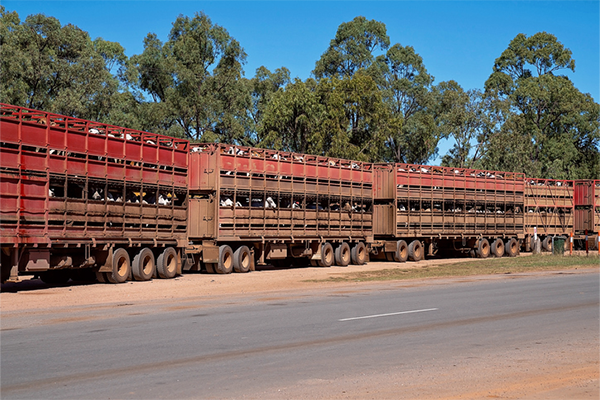By Nichola Davies / LGAQ Digital Journalist
Traversing an area of almost 218,000km² in central and western Queensland are roads that comprise a strategic web of vital agricultural supply chains. It’s an area that’s home to a quarter of the nation’s beef herd, where all aspects of beef production occur—breeding, backgrounding, fattening, feedlotting, finishing, processing and exporting.
As such, it’s an economic powerhouse, but this network of roads—dubbed the Queensland Beef Corridors (QBC) by seven councils in the area—is in serious need of upgrading, the lack of which is hampering the industry’s growth.
The region’s product, which is in huge demand nationally and internationally, is transported on substandard roads that have changed very little and are disrupted by factors that have remained unchanged for some 150 years.

Beef cattle being loaded onto road trains in far western Queensland. Image courtesy John Carnemolla.
Spokesperson for the QBC, Central Highlands Regional Council Mayor Kerry Hayes, says the beef industry has always been an economic cornerstone of central Queensland.
“This is a legacy issue that has been going on for decades, effectively,” Mayor Hayes said.
“It’s probably been 40 years since the development of the Fitzroy Development Road—the old Beef Road, ironically called the Beef Road.
“That was the last time that State Government really strategically invested in our industry, and the living industry in central Queensland, which is agriculture.”
Mayor Hayes explains that, in the intervening period, the size of the herd has grown—with its quality increasing as genetics have improved—and the volume and capacity of processing also on the rise.

Image courtesy Lakeview Images.
“All of those things have changed, and it has been under the stewardship of farmers and property owners and the private sector,” he said.
“There’s been no other investment in the growing network of roads that service all of that productive area.”
The roadways under the Queensland Beef Corridors banner are the effective connectivity of local governments to each other and to the broader supply chain that goes right out through the Port of Gladstone and processing facilities in Rockhampton and Biloela.
Mayor Hayes says with the industry’s outputs increasing exponentially over the last 30 to 40 years, it’s a case of saying, “We can be a very contemporary industry, in that we’re innovative, we’ve got forward sale contracts, we’ve got commitments, we’re acting like businesses—not like ‘poor old farmers’—and what we’re saying is the only thing that’s lagging is the infrastructure that gets our product all around.
“What’s the point of having a wonderful, viable agreement to supply and sell if when I get an inch of rain I can’t even deliver, or I’ve got to ask for another two weeks? That’s not an acceptable excuse in a modern supply chain.”

Image courtesy Michele Jackson
The QBC councils teamed up with industry and primary producers and launched the QBC campaign in early 2021 to highlight the stranglehold the sub-par road network has on the growing industry and secured a $400 million commitment in last October’s Federal Budget.
While they are called the ‘Queensland Beef Corridors’, it’s not just about beef—these roads service broadacre farming, irrigation and small communities too.
Mayor Hayes says it’s important now to work with the State Government on delivering the upgrades, bearing in mind the roads are State assets.
“The danger would be that local government is not included in the sensible prioritisation and roll-out of the money,” Mayor Hayes said.
“We would hope that we would do it in a way that was sensible, and we’d all sit down and work it out with the State.
“The great danger is that the State gets this money and says, ‘Well, you know what, with our programs and our forward planning X Y Z...’, and we don’t see that money for a long time, or it disappears or gets used for something else.”
In addition to the $400 million from the Federal Government, the QBC is seeking $178 million from the State Government—plus a collaborative roll-out.